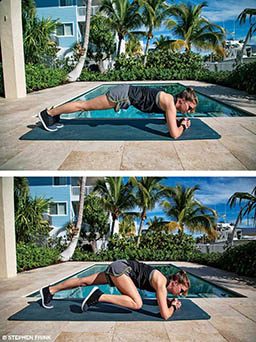Affordable, wearable heart-rate monitoring technology is changing the way we work out. Heart-rate training allows people to accurately determine their exercise intensity, which can be used to promote significant gains in areas such as aerobic capacity. This can lead to better overall fitness and fitness to dive.
Heart-rate training was previously reserved for elite athletes because accurate monitoring technology was prohibitively expensive. Now anyone with a smartwatch can track their heart rate and gauge how hard they are working in comparison to their maximum heart rate. People with certain cardiovascular risk factors or who take heart-rate regulatory medication such as beta blockers should consult their physicians before attempting aerobic exercise. Heart-rate training may not be appropriate for this population.
A variety of formulas can be used to determine a person’s upper and lower limits of heart-rate training, or training zone, but for simplicity we will use the heart-rate reserve (HRR) equation, which considers cardiovascular efficiency (in the form of resting heart rate) and age. Find your training zone with the following steps:
First, determine your predicted maximum heart rate (MHR) by subtracting your age from 220. This rate may vary by up to 12 beats per minute. (Predicted MHR = 220–age)
Next, find your resting heart rate (RHR) by counting your heart beats per minute or checking your heart-rate monitor. Make sure you are seated and at rest for a few minutes prior to checking your RHR. Now calculate your HRR by subtracting your RHR from your predicted MHR. (HRR = Predicted MHR–RHR)
For example, the HRR for a 40-year-old person with a resting heart rate of 70 beats per minute (bpm) is calculated as follows:
Step 1: Predicted MHR = 220–40 = 180 bpm
Step 2: RHR = 70 bpm
Step 3: HRR = 180 bpm–70 bpm = 110 bpm
Use your HRR to identify your estimated aerobic training zone for your estimated heart rate as indicated by your monitor. Most training protocols use three to five zones. We are targeting aerobic endurance, so we will consider three training zones. Your main workout should remain in the aerobic zone (60 to 80 percent of your calculated maximum heart rate).
| Zone | Description | Calculation |
| Zone 1 | 50 to 60 percent of your calculated maximum heart rate (Use this zone for your warm up and cool down, or start here if you are just beginning a fitness program.) | (_____ HRR x 0.50) + _____ (RHR) |
| Zone 2 | 60 to 80 percent of your calculated maximum heart rate (Stay in this zone for aerobic training. You should be able to comfortably hold a conversation.) | (_____ HRR x 0.60) + _____ (RHR) = lower limit of aerobic training zone (_____ HRR x 0.80) + _____ (RHR) = upper limit of aerobic training zone |
| Zone 3 | More than 80 percent of your calculated maximum heart rate (If your heart rate enters this zone, slow down because you are transitioning to more anaerobic activity.) | (_____ HRR x 0.80) + _____ (RHR) |
For example, a 40-year-old person with a HRR of 110 bpm and RHR of 70 bpm would have a lower limit of 136 bpm and an upper limit of 158 bpm for aerobic training.
The Workout
Step Ups

- Stand in front of the step.
- Step up with your right foot, followed by your left foot (up-up).
- Step down with your right foot, followed by your left foot (down-down).
- Repeat, starting with the alternate foot.
- Continue for two minutes.
Modification: Lower the height of the step, or reduce the speed of stepping.
Challenge: Increase the height of the step or the speed of stepping.
High Knees with a Kick

- Lift up your right knee to your waist (if possible).
- Extend your knee so your foot is forward and leg is straight.
- Bend your knee.
- Place foot down on the ground.
- Repeat on the opposite side.
- Continue for two minutes.
Tip: The workload kicks in after the first 30 seconds.
Modification: Start near a wall until your balance improves.
Challenge: Gradually become less reliant on the wall.
Mountain Climber from Plank

- Start in plank position on your forearms, with your elbows below your shoulders.
- Keep your body straight.
- Bring your knee toward your chest while maintaining a flat back.
- Return to the starting position, and repeat on the opposite side.
- Continue for two minutes.
Modification: Elevate your upper body on a box, step or stable chair.
Challenge: Keep a flat back, and bring your knee all the way to your arms.
Windshield Wipers

- Lie on your back with your arms out.
- Keep your knees bent in tabletop position.
- Rotate your knees slowly to one side without letting your knees touch the floor.
- Repeat on the opposite side.
- Continue for two minutes.
Modification: Don’t bring your knees down very far.
Challenge: Extend your legs straight.
Side Plank with Rotation

- Start in a side plank position on your right forearm.
- Raise up your left arm to the ceiling.
- Rotate your body, threading your left arm under your body.
- Return to the starting position.
- Repeat on the opposite side.
- Continue for 60 seconds on each side.
Modification: Put your knee on the floor.
NOTE: To avoid an increased risk of decompression sickness, DAN® recommends that divers avoid strenuous exercise for 24 hours after making a dive. During your annual physical exam or following any changes in your health status, consult your physician to ensure you have medical clearance to dive.
© Alert Diver — Q1 2019